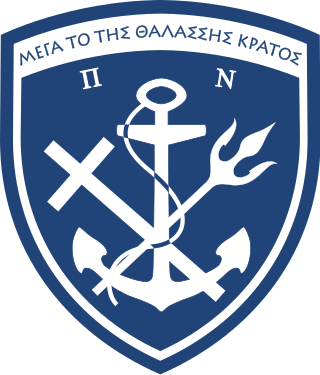
A cruiser is a type of warship. Modern cruisers are generally the largest ships in a fleet after aircraft carriers and amphibious assault ships, and can usually perform several operational roles from search-and-destroy to ocean escort to sea denial.
The United States Navy, United States Coast Guard, and United States National Oceanic and Atmospheric Administration (NOAA) use a hull classification symbol to identify their ships by type and by individual ship within a type. The system is analogous to the pennant number system that the Royal Navy and other European and Commonwealth navies use.

A naval ship is a military ship used by a navy. Naval ships are differentiated from civilian ships by construction and purpose. Generally, naval ships are damage resilient and armed with weapon systems, though armament on troop transports is light or non-existent.

A ship class is a group of ships of a similar design. This is distinct from a ship type, which might reflect a similarity of tonnage or intended use. For example, USS Carl Vinson is a nuclear aircraft carrier of the Nimitz class.

A warship or combatant ship is a ship that is built and primarily intended for naval warfare. Usually they belong to the armed forces of a nation. As well as being armed, warships are designed to withstand damage and are typically faster and more maneuverable than merchant ships. Unlike a merchant ship, which carries cargo, a warship typically carries only weapons, ammunition and supplies for its crew. Warships usually belong to a navy, though they have also been operated by individuals, cooperatives and corporations.

The Hellenic Navy is the naval force of Greece, part of the Hellenic Armed Forces. The modern Greek navy historically hails from the naval forces of various Aegean Islands, which fought in the Greek War of Independence. During the periods of monarchy it was known as the Royal Hellenic Navy.

The Soviet Navy was the naval warfare uniform service branch of the Soviet Armed Forces. Often referred to as the Red Fleet, the Soviet Navy made up a large part of the Soviet Union's strategic planning in the event of a conflict with the opposing superpower, the United States, during the Cold War (1945–1991). The Soviet Navy played a large role during the Cold War, either confronting the North Atlantic Treaty Organization in western Europe or power projection to maintain its sphere of influence in eastern Europe.
The names of commissioned ships of the United States Navy all start with USS, for United States Ship. Non-commissioned, primarily civilian-crewed vessels of the U.S. Navy under the Military Sealift Command have names that begin with USNS, standing for United States Naval Ship. A letter-based hull classification symbol is used to designate a vessel's type. The names of ships are selected by the Secretary of the Navy. The names are those of states, cities, towns, important persons, important locations, famous battles, fish, and ideals. Usually, different types of ships have names originated from different types of sources.
The development of the steam ironclad firing explosive shells in the mid-19th century rendered sailing ship tactics obsolete.

The 3"/50-caliber gun in United States naval gun terminology indicates the gun fired a projectile 3 inches (76 mm) in diameter, and the barrel was 50 calibers long. Different guns of this caliber were used by the U.S. Navy and U.S. Coast Guard from 1900 through to 1990 on a variety of combatant and transport ship classes.

The Free French Naval Forces were the naval arm of the Free French Forces during the Second World War. They were commanded by Admiral Émile Muselier.
Axis & Allies Naval Miniatures: War At Sea is a standalone miniature wargame, originally produced by Avalon Hill, later by Wizards of the Coast. Axis and Allies Naval Miniatures gameplay is associated with Axis & Allies Miniatures, a World War 2 land battles game also made by Avalon Hill, but the two games are very different. Players take command of miniatures that are 1/1800 scale and represent fleets of individual warships, submarines, and squadrons of Aircraft.

The Cuban Revolutionary Navy is the navy of Cuba.
This glossary defines the various types of ships and accessory watercraft that have been used in service of the United States. Such service is mainly defined as military vessels used in the United States Navy and United States Coast Guard, as well as the defunct, incorporated, or renamed institutions such as the United States Revenue Cutter Service. Service of the United States can also be defined in this context as special government missions in the form of expeditions, such as the Wilkes Expedition or the North Pacific Exploring and Surveying Expedition. The scope of the glossary encompasses both the "Old Navy" of the United States, from its beginnings as the "Continental Navy", through the "New Navy" and up to modern day. The watercraft included in the glossary are derived from United States ships with logbooks published by the National Archives and Records Administration.